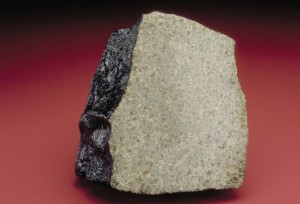One Hundred Years Ago Today, A Mars Meteorite Fell in a Blaze
Today marks the 100th anniversary of the Nakhla meteorite falling to Earth. See and touch this piece of Mars at the Natural History Museum
/https://tf-cmsv2-smithsonianmag-media.s3.amazonaws.com/filer/20110628103004nakhla-meteorite-thumb.jpg)
On the morning of June 28, 1911, somewhere between 8:30 and 9:00 in the morning, a fireball was observed northwest of Alexandria, Egypt. Few would realize what it was. But soon after, W.F. Hume, minister of the Geological Survey of Egypt, began taking eyewitness statements, and two months later published his report, “The First Meteorite Record in Egypt.”
One of those statements, from a farmer who claimed to have seen a fragment fall on a dog, gave rise to the popular myth that Nakhla, as the meteorite would be named, was “the dog killing meteorite,” an unsubstantiated claim, but the dramatic account is irresistible: “The fearful column which appeared in the sky at Denshal was substantial. The terrific noise it emitted was an explosion which made it erupt several fragments of volcanic materials. These curious fragments, falling to earth, buried themselves into the sand to the depth of about one metre. One of them fell on a dog. . .leaving it like ashes in a moment.”
Approximately 40 stones were recovered southeast of Alexandria, near the town of Abu Hummus. Of the stones recovered, Hume immediately sent two of them to the Smithsonian Institution, weighing 117g and 52g (or 4.3 4.13 ounces and .117 1.83 ounces). They arrived in August of 1911 and have been a part of the Natural History Museum’s collections ever since. Today, we celebrate the 100th anniversary of Nakhla’s landing.
“At the time that Nakhla fell, we didn’t know that any of these were from Mars,” says Cari M. Corrigan, a geologist in the Division of Meteorites at the Natural History Museum. “All we knew was that they were different from the rest of the meteorites that we had, in general.”
Looking at the crystalline composition of the stones, it was clear that they had come from some sort of planetary body that had seen geologic processes, like volcanoes, and that the ‘parent body’ they came from had to be big enough for that kind of igneous activity to have taken place, Corrigan says.
Asteroids were ruled out, because they weren’t big or complex enough, so scientists started looking at other planets. “They didn’t say Mars, but Mars-like, or the moon, or something that size,” says Linda Welzenbach, collection manager of the National Meteorite Collection. Mars was a theory, but there was debate about whether or not you could actually get rocks, similar to what was found, off of Mars without them completely melting.
“There was very little science done on this rock until the late 1960s, early 1970s,” says Welzenbach, and identifying it was the result of a coalescence of information. A direct link was established in 1976 when the Viking spacecraft analyzed the Martian atmosphere. In 1983, scientists at NASA’s Johnson Space Center did a study where they measured some gases trapped in another Martian meteorite and compared that to the Viking landed atmospheric data. Their relationship to Nakhla was evident and in 1983, Nakhla was officially recognized as a piece of Mars.
“Part of the reason it is significant to us is because it’s from Mars and it’s one of the first meteorites from Mars that we had,” Corrigan says. The first meteorite from Mars was Chassigny, which fell in 1815, followed by Shergotty, which fell in 1865. After Nakhla, there were no other Martian rocks until 1962 when Zagami fell in Nigeria, Welzenbach says.
“Studying these rocks has helped us understand the geologic history of Mars,” says Corrigan, “the interior and the geochemistry as whole, how the planet evolved.”
Of the two original stones sent to the museum in 1911, the smaller one was eventually cut and used for scientific study, while the other has remained pretty much untouched since it fell. In 1962, E.P. Henderson, curator of the museum’s Division of Mineralogy and Petrology, as it was called at the time, wrote to the Geological Survey requesting some more material. They received 480g in 1962, a big piece—almost 17 ounces—and which is on display in the museum. Two smaller pieces arrived in 1977. The museum’s total holdings of Nakhla amounts to 650g, about 23 ounces.
Visitors can touch a piece of the 1.3 billion-year-old meteorite— young in comparison to most of the meteorites from the asteroid belt which are 4.5 billion years old—at the National Museum of Natural History.
/https://tf-cmsv2-smithsonianmag-media.s3.amazonaws.com/accounts/headshot/Arcynta-Ali-240.jpg)

/https://tf-cmsv2-smithsonianmag-media.s3.amazonaws.com/accounts/headshot/Arcynta-Ali-240.jpg)